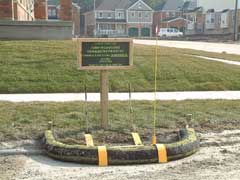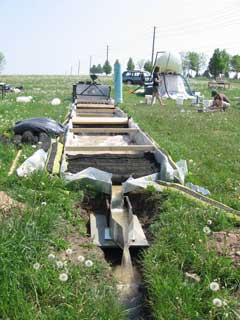Compost Biofilters for Stormwater Management
 Compost biofilters are a promising, low cost erosion and sediment control technology with the potential to serve various functions based on placement and configuration of the product. Typical uses may include filtration of sheet flows on sloping land, capturing sediment in ditches, preventing polluted flows from entering sewer grates and protection against bank erosion.
Compost biofilters are a promising, low cost erosion and sediment control technology with the potential to serve various functions based on placement and configuration of the product. Typical uses may include filtration of sheet flows on sloping land, capturing sediment in ditches, preventing polluted flows from entering sewer grates and protection against bank erosion.
Compost is an excellent filtration medium because of its contaminant-binding potential. It is also cheap, readily available in a variety of textures, and provides a suitable use for excess compost (particularly the coarse textured ‘overs’) generated in Ontario as a result of recent waste diversion strategies implemented by the provincial government.
This on-going study was initiated in 2006 to address the need for Canadian data on the effectiveness of biofilters as a stormwater treatment and erosion and sediment control technology. Guelph University conducted laboratory and  pilot scale field testing of the biofilters, and Toronto and Region Conservation Authority (TRCA) performed a full-scale field evaluation as part of the larger Guelph study. Some of the objectives of the Guelph University work were to:
pilot scale field testing of the biofilters, and Toronto and Region Conservation Authority (TRCA) performed a full-scale field evaluation as part of the larger Guelph study. Some of the objectives of the Guelph University work were to:
- determine flow-through properties of the biofilter and rationalize its hydraulic design;
- evaluate the effectiveness of the biofilter in removing contaminants from runoff;
- determine the extent to which the addition of a polymer would assist in fine particle removal; and
- assess how long the biofilters would remain an effective filtration medium under various conditions.
In the full-scale field evaluation conducted by TRCA in Kleinburg, Ontario, the biofilter was evaluated as a sediment control technology for effluent from a temporary construction sediment control pond. Since the effluent from these ponds typically contains very fine suspended solids, the intent of the study was to determine (i) the capacity of biofilters to remove fine particulate matter, and (ii) how variations in pond outflow rates affect suspended solids removal.
